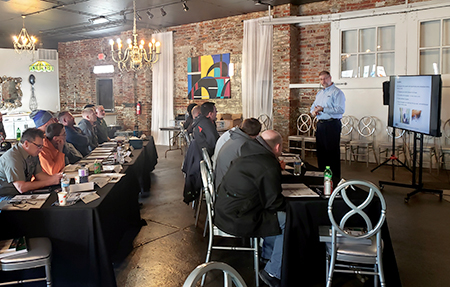The same goes for training. If we aren’t continuously holding classes and teaching sessions, the lessons slip away, and techs tend to revert to old routines and habits. That is human nature.
So training is a process that must be maintained and nurtured continuously.
Furthermore, we use our training programs to determine a technician’s capabilities. This helps us note his or her strengths and weaknesses and enables us to plan for the training necessary for them to grow. It is up to them to want to ‘climb the ladder.’ We provide the ‘rungs.’ The truth is, the more advanced a tech becomes, the more valuable he or she becomes.
Training and the COVID Pandemic
We have made training a vital component of our culture. With the onslaught of the pandemic, however, our training regimen was seriously interrupted because the shutdowns and social distancing rules make it very difficult to get the teams together for training. In the spring, we missed many weeks of regular training and obviously missed NCI classes as well. We have noticed the impact of that on our operating efficiencies and in company growth.
For example, when we look at whether techs are conducting static pressure tests on every call, we are finding they are slipping because we stopped getting together to talk about it. After all, there weren’t any meetings and training sessions due to the COVID situation.

At Getzschman, internal virtual training has not been fully implemented. At the beginning of the shutdowns, we simply didn’t have the technology or skills to set these types of sessions up. Because there is no end to this pandemic in sight, we are seriously looking into a virtual approach today and suggest that if training is important to you, you need to develop virtual capabilities as well.
The good news is that NCI and other organizations have developed virtual training and that certainly helps. A lot. But we still believe that live, face-to-face meetings work better because it gives our guys the ability to interact with each other and the instructors more fully. Plus, there is the hands-on component which is so important when teaching technicians how to troubleshoot, take static pressure readings, install testing ports, and so on.
But for now, and in the near future, those types of meetings just aren’t going to happen as regularly.
Seven Key Tips to Successful Training Programs
People often say, ‘Training your people is just a waste of money because they will just leave you for a competitor anyway.’
We don’t agree.
You can spend money on training and while you have those employees, they will do the right things for you and your customers. We don’t have a lot of turnover, possibly BECAUSE of the training we provide.
Here are seven tips that we’ve found work in our company:
Commitment to Training and the Process – That commitment must extend beyond classes you hold internally to those you need that are held in other locations. This includes training provided by manufacturer reps and equipment suppliers, as well as third parties like trade associations and membership groups like NCI.
Click below for next page













Recent Comments